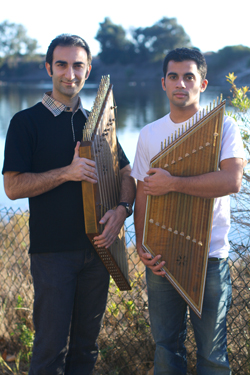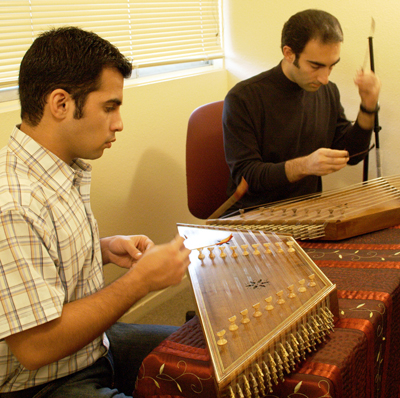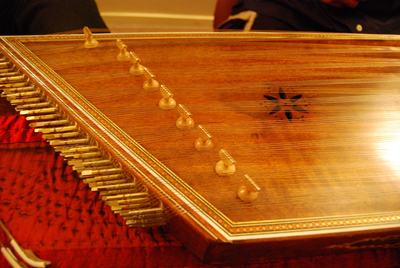 As a child, Bahram Osqueezadeh’s early fateful encounter with an instrument he would eventually master occurred as he approached the trapezoidal stringed wooden object sitting on a table on the top floor of his family’s home in Tehran. His elder brother had brought the instrument home and left it in a room on a table, its many strings evoking its namesake—santur—literally meaning “one hundred strings.” A curious Osqueezadeh reached out to one of the strings, plucked it, and let the sound resonate for seconds as he listened. Then he plucked another string and listened deeply. And another. As he basked in the individual resonance of each string, one could say it was love at first pluck.
As a child, Bahram Osqueezadeh’s early fateful encounter with an instrument he would eventually master occurred as he approached the trapezoidal stringed wooden object sitting on a table on the top floor of his family’s home in Tehran. His elder brother had brought the instrument home and left it in a room on a table, its many strings evoking its namesake—santur—literally meaning “one hundred strings.” A curious Osqueezadeh reached out to one of the strings, plucked it, and let the sound resonate for seconds as he listened. Then he plucked another string and listened deeply. And another. As he basked in the individual resonance of each string, one could say it was love at first pluck.
Now a seasoned performer, instructor and scholar based in Goleta—a town neighboring Santa Barbara and the University of California, Santa Barbara (UCSB)—Osqueezadeh is participating in ACTA’s Apprenticeship Program as a master artist working with fellow Goleta-resident, neighbor and apprentice Areo Saffarzadeh. The santur is a hammered dulcimer with relatives in Iraq, Turkey, Pakistan, Armenia, India, Greece and elsewhere in Asia. The apprenticeship focuses on developing Saffarzadeh’s playing skill, and serves as Saffarzadeh’s ongoing introduction into the essence and backbone of Persian music, known as the Radif.
The Radif is a collection of ancient melodies handed down over generations, providing the structural underpinning of Persian classical repertoire. The Radif is further organized into seven dastgāh and five derivatives named āvāz, musical modes which each contain a tonically distinct eight-note scale. Within each dastgāh exists a repertory of melodies which constitutes goosheh (also gushe). Osqueezadeh plans on covering several dastgāh with Saffarzadeh during the apprenticeship, starting with Shur and touching upon other dastgah including Bayāt-e Isfāhān and Dashti, an auxiliary dastgāh—or āvāz —connected to Shur. Each lesson covers an average of one goosheh. Their goals in working with the dastgāh are to develop Saffarzadeh’s understanding of a dastgāh’s melodic contours and its shāhed (the primary, pivotal note of each dastgāh); adding more technical pieces and drills to Saffarzadeh’s growing repertoire which demand stronger technicality, virtuosity, and proper use of the mezrab (thin wooden mallets used to strike the strings of the santur); introducing Chāhārmezrāb (metric pieces and a compositional style which are commonly virtuosic and quick in tempo); and developing Saffarzadeh’s tuning ability. Each of these goals ultimately is oriented towards versing Saffarzadeh in the Radif, and intend to transmit the theory and structure of Persian music to develop Saffarzadeh’s fluency in “how to work within a beat, how to play it, how to build it.” Improvisation within the Radif’s parameters is a long term goal beyond the apprenticeship, considered the highest level of musicianship in the tradition.
Classical Persian musical pedagogy dictates strict sequential learning of the dastgāhs, typically moving to the next dastgāh only after thoroughly acquainting oneself with the preceding one. Arriving in the United States almost a decade ago, Osqueezadeh has reflected on “mixing it up more” as a teacher, despite the fact that he describes himself as “the kind of person that has to finish everything, to make sure everything is there” and instructing the dastgāh one at a time. During the course of their apprenticeship, Osqueezadeh has guided Saffarzadeh back and forth between different dastgāhs in a thoughtful and liberal manner in order to instill a sense of the bigger picture of the Radif. Reflecting on his role in mentoring and engaging Saffarzadeh, he comments: “That’s what I am learning—trying to find the balance between the tradition and something that keeps people in this tradition. I have to think about a way to make it more interesting for Areo, because not everyone is going to be like him. Other people may quit.”
 Working in a sophisticated musical tradition which requires meticulous precision, memorization and firm theoretical understanding, Saffarzadeh admits there are some pieces which he is more fond of playing than others within the repertoire, and recognizes that he likes variety and “being able to change it up” once in a while during the apprenticeship. Despite this, and Osqueezadeh’s occasional willingness to navigate Saffarzadeh through yet-familiar dastgāhs, both of them are committed to the traditionality of the form. Saffarzadeh recognizes the importance of grasping the Radif’s larger framework and “see[s] the importance of learning the pieces. In one piece I may learn a couple of techniques, and then another day, I will find that those same techniques are in the next piece, but harder and little different. Once you learn the dastgāhs you can see the similarities and differences. Being able to highlight, compare and contrast those gives you a sense of what they really are.”
Working in a sophisticated musical tradition which requires meticulous precision, memorization and firm theoretical understanding, Saffarzadeh admits there are some pieces which he is more fond of playing than others within the repertoire, and recognizes that he likes variety and “being able to change it up” once in a while during the apprenticeship. Despite this, and Osqueezadeh’s occasional willingness to navigate Saffarzadeh through yet-familiar dastgāhs, both of them are committed to the traditionality of the form. Saffarzadeh recognizes the importance of grasping the Radif’s larger framework and “see[s] the importance of learning the pieces. In one piece I may learn a couple of techniques, and then another day, I will find that those same techniques are in the next piece, but harder and little different. Once you learn the dastgāhs you can see the similarities and differences. Being able to highlight, compare and contrast those gives you a sense of what they really are.”
Osqueezadeh is attuned to and accommodates Saffarzadeh’s interests, tapping into areas of the Radif which pique Saffarzadeh’s drive to practice and stay committed as a traditional musician. Saffarzadeh appreciates that Osqueezadeh ultimately “keeps the lessons within the framework of the tradition” and that Osqueezadeh’s “gentle push” brings Saffarzadeh closer to understanding the tradition.
Inherent in their dynamic are differences in culture and generation, Saffarzadeh being American-born and fourteen years Osqueezadeh’s junior. These dynamics enrich their relationship, as Osqueezadeh observes that “because of Areo’s intelligence, I can talk to him. Usually students and teachers have a one-way road, but actually I say to him, ‘Do you really like this? Do you want to work on this?'” Equally as significant to the apprenticeship, each of them brings a rich musical background outside of the world of the Radif and the santur. Osqueezadeh is a composer who writes pieces for a diverse range of instrumentation, from string orchestras to Iranian ensembles to flute and viola to electronic music. He is also additionally trained as a musician in both piano and the Persian percussive tombak, and has a background in ethnomusicology and music theory. Saffarzadeh has played guitar since he was 11-years old, plays in a local band, and picked up Persian percussion instruments like the daf prior to playing the santur, and, according to Osqueezadeh, “He raps pretty good.” Each of their multiple musical facets allow them to connect more deeply as musicians and serves as an important anchor to their apprenticeship together in santur.
Frequently, lessons are preceded by dinners and discussion together. “Areo is part of my life. It’s a part of the culture. Here in California, we are a little more traditional [than modern day Tehran]. There, there are more formal relationships between students and teachers. I actually broke that even there. My students were more comfortable there. You cannot keep the younger generation in boxes of ‘You have to do this. You have to do that.’ We teachers have to change too. I was under a lot of pressure from my teachers. But the point was that I was in love with the santur also. With this [current] generation the love comes next, not first. I think when Areo started he came because he respected his culture, but now he continues studying because he likes it. There was an intellectual component, which turned into an emotional component.”
Saffarzadeh’s parents always stressed Persian culture as he grew up in Chicago. “I would always wake up on Sunday morning hearing my dad playing Persian music in the house. There were times where I rejected it and there times where I embraced it depending on the music and the style.” He was first exposed as a teenager to Persian percussion while he was pursuing his guitar studies and took to it easily, extending his practice by joining the UCSB Middle East Ensemble when he was a student there. When Osqueezadeh arrived at UCSB in 2002 to pursue his Ph.D in Music Composition, Saffarzadeh first witnessed Osqueezadeh playing virtuosically and recalls that “hearing him play the santur, I was in awe. This is amazing. I want to learn santur.”
 “The fact that santur has percussive and melodic components attracted me to it. But seeing Bahram play was the thing that sold me.” They eventually began working together in 2005, Osqueezadeh offering many private lessons without charge in exchange for one key thing—Saffarzadeh’s commitment to the santur. Osqueezadeh notes that Saffarzadeh “will be an exceptional ambassador of this art tradition…he has the best potential to advocate, preserve and promote this musical tradition.”
“The fact that santur has percussive and melodic components attracted me to it. But seeing Bahram play was the thing that sold me.” They eventually began working together in 2005, Osqueezadeh offering many private lessons without charge in exchange for one key thing—Saffarzadeh’s commitment to the santur. Osqueezadeh notes that Saffarzadeh “will be an exceptional ambassador of this art tradition…he has the best potential to advocate, preserve and promote this musical tradition.”
Osqueezadeh himself has been a staunch proponent of Persian classical music, having worked with Santur masters including Faramarz Payver, Parviz Meshkatian, Masoud Shenasa, and a master of Persian Radif, Majid Kiani while at the University of Tehran. Ultimately, he left a growing career as a software engineer to become a full time musician, composer and scholar. “From daily life to special occasions, the music has been an inspirational force in my life to work and be creative.” Flourishing as a performer and as an important member of the Persian musical community in Southern California, he appreciates how the Apprenticeship Program has supported his work with Saffarzadeh. Santur, he notes, comes from “another tradition. From another country. And here in California, we are actually getting support to do this. It’s amazing.”
That this apprenticeship occurs in a place like Goleta is even more striking. Incorporated as its own municipality in 2002, with a population slightly over 55,000, Goleta is an unlikely place for an apprenticeship in Persian classical music to bloom, easily overshadowed by its southern metropolitan neighbor Los Angeles, which has an Iranian-American population estimated at up to 500,000. “Areo is an amazing kid. I think [the tradition] will be in good hands. I am so lucky to have him in this small town working with him.”
In turn, Saffarzadeh comments on their lives together in a coastal town: “For me I couldn’t ask for anything more—to have an amazing teacher that’s four blocks away. Bahram’s the only person I have a chance to speak Farsi with. In a sense just meeting with him every week is not only connecting me more with my culture in terms of music and learning an instrument, but about going back and practicing my language that was native to me. In keeping with traditional music, I am also learning about Persian tradition in general.”
Above all, the course of their apprenticeship has fostered a shared love for the stringed instrument, which dates back an estimated 2,000 years. When Saffarzadeh talks about the santur’s resonance and its sustained notes, his comments evoke the same love and spirit which first held Osqueezadeh rapt as a child. “The way that the santur resonates and fills the room—if you are playing, not only is it demanding your attention and requiring precision, but it captures the attention in the room.”
